-
Cangzhou Yulong Steel Co., Ltd.
-
Phone:
+86 13303177267 -
Email:
admin@ylsteelfittings.com
- English
- Arabic
- Italian
- Spanish
- Portuguese
- German
- kazakh
- Persian
- Greek
- French
- Russian
- Polish
- Thai
- Indonesian
- Vietnamese
- Zulu
- Korean
- Uzbek
- Hindi
- Serbian
- Malay
- Ukrainian
- Gujarati
- Haitian Creole
- hausa
- hawaiian
- Hebrew
- Miao
- Hungarian
- Icelandic
- igbo
- irish
- Japanese
- Javanese
- Kannada
- Khmer
- Rwandese
- Afrikaans
- Albanian
- Amharic
- Armenian
- Azerbaijani
- Basque
- Belarusian
- Bengali
- Bosnian
- Bulgarian
- Catalan
- Cebuano
- China
- China (Taiwan)
- Corsican
- Croatian
- Czech
- Danish
- Esperanto
- Estonian
- Finnish
- Frisian
- Galician
- Georgian
- Kurdish
- Kyrgyz
- Lao
- Latin
- Latvian
- Lithuanian
- Luxembourgish
- Macedonian
- Malgashi
- Malayalam
- Maltese
- Maori
- Marathi
- Mongolian
- Myanmar
- Nepali
- Norwegian
- Norwegian
- Occitan
- Pashto
- Dutch
- Punjabi
- Romanian
- Samoan
- Scottish Gaelic
- Sesotho
- Shona
- Sindhi
- Sinhala
- Slovak
- Slovenian
- Somali
- Sundanese
- Swahili
- Swedish
- Tagalog
- Tajik
- Tamil
- Tatar
- Telugu
- Turkish
- Turkmen
- Urdu
- Uighur
- Welsh
- Bantu
- Yiddish
- Yoruba

Dec . 12, 2024 22:39 Back to list
pipe welding rod types
Understanding Pipe Welding Rod Types
Welding is an essential process in various industries, including construction, manufacturing, and repair work. One of the critical aspects of welding is the choice of welding rods, especially when dealing with pipe welding. The selection of the appropriate welding rod can significantly affect the quality, strength, and longevity of the weld. This article will explore the different types of pipe welding rods, their applications, and key considerations when selecting them.
Types of Pipe Welding Rods
1. Mild Steel Welding Rods Mild steel rods are among the most commonly used types of welding rods for pipe welding. They are favored for their versatility and ease of use. These rods typically contain a low carbon content, making them easier to weld and resulting in less spatter. Mild steel rods are suitable for welding carbon steel pipes in a variety of applications, including structural welding and machinery repairs.
2. Stainless Steel Welding Rods Stainless steel rods are used when a corrosion-resistant weld is required. These rods contain chromium and nickel, which enhance their resistance to rust and oxidation. Stainless steel welding rods are ideal for pipelines that carry corrosive substances or are exposed to harsh environmental conditions. They are often used in the food, pharmaceutical, and chemical industries due to their hygienic properties and durability.
3. Aluminum Welding Rods Aluminum rods are specifically designed for welding aluminum pipes. These rods often have a higher silicon content, which helps improve fluidity and reduces the chances of cracking. Aluminum is lightweight and has excellent corrosion resistance, making it a popular choice for applications in aerospace, automotive, and marine industries. When welding aluminum, it is essential to maintain a clean surface, as aluminum oxide can adversely affect the weld quality.
4. Copper Welding Rods Copper welding rods are utilized for welding copper pipes and have excellent thermal and electrical conductivity. They are frequently used in plumbing and HVAC applications. Copper rods can be challenging to work with due to their high thermal conductivity, which can lead to rapid heat dissipation. Therefore, careful control of the welding process is crucial for achieving strong, defect-free joints.
5. Nickel Alloy Welding Rods For applications involving high temperatures and corrosive environments, nickel alloy rods are often employed. These rods offer exceptional resistance to oxidation, heat, and corrosion, making them ideal for welding pipes used in chemical processing, power generation, and marine environments. Nickel alloy rods require specific welding techniques and are typically more expensive than other types.
Key Considerations in Selecting Pipe Welding Rods
pipe welding rod types

When choosing the appropriate welding rod for pipe welding, several factors should be considered
- Material Compatibility The welding rod must be compatible with the base material of the pipes being welded
. Using a rod with different properties can lead to weak or brittle joints.- Welding Environment The working environment plays a crucial role in rod selection. For outdoor welding, consider rods that perform well under windy or damp conditions.
- Weld Position The position of the weld, whether flat, horizontal, overhead, or vertical, impacts the choice of the welding rod. Some rods are designed for specific welding positions.
- Welding Process Different welding processes (SMAW, TIG, MIG, etc.) may require different types of rods. Understanding the specific requirements of each process will help in selecting the appropriate rod.
- Cost and Availability While it's important to choose high-quality rods, budget constraints may affect your options. Assess availability in your local market to avoid delays in projects.
Conclusion
Choosing the right welding rod for pipe welding is critical to achieving durable and reliable joints. With various types of rods available—each with unique properties and applications—understanding their characteristics and compatibility with the base materials is essential. By considering the factors discussed, welders can make informed decisions, leading to successful welding outcomes in various industrial applications.
Latest news
-
ANSI 150P SS304 SO FLANGE
NewsFeb.14,2025
-
ASTM A333GR6 STEEL PIPE
NewsJan.20,2025
-
ANSI B16.5 WELDING NECK FLANGE
NewsJan.15,2026
-
ANSI B16.5 SLIP-ON FLANGE
NewsApr.19,2024
-
SABS 1123 FLANGE
NewsJan.15,2025
-
DIN86044 PLATE FLANGE
NewsApr.19,2024
-
DIN2527 BLIND FLANGE
NewsApr.12,2024
-
JIS B2311 Butt-Welding Fittings LR/SR 45°/90° /180°Seamless/Weld
NewsApr.23,2024











